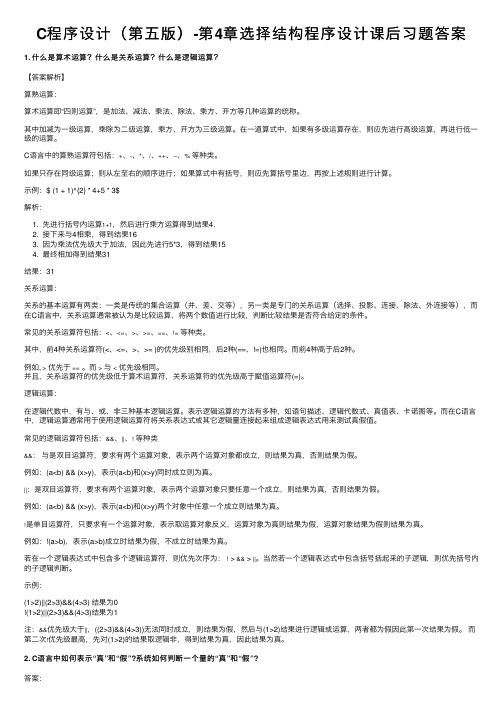R语言第四章第五章课后习题答案
- 格式:docx
- 大小:46.31 KB
- 文档页数:3

第五章答案5.2:实现i s o d d()函数,参数为整数,如果参数为奇数,返回t r u e,否则返回f a l s e。
def isodd(s):x=eval(s)if(x%2==0):return Falseelse:return Truex=input("请输入一个整数:")print(isodd(x))请输入一个整数:5True5.3:实现i s n u m()函数,参数为一个字符串,如果这个字符串属于整数、浮点数或复数的表示,则返回t r u e,否则返回f a l s e。
def isnum(s):try:x=eval(s)if((type(x)==int)|(type(x)==float)|(type(x)==complex)):return Trueelse:return Falseexcept NameError:return Falsex=input("请输入一个字符串:")print(isnum(x))请输入一个字符串:5True题5.4:实现m u l t i()函数,参数个数不限,返回所有参数的乘积。
def multi(x):xlist=x.split(",")xlist = [int(xlist[i]) for i in range(len(xlist))] #for循环,把每个字符转成int值num=1for i in xlist:num=num*iprint(num)s=input("请输入数字,并用,号隔开:")multi(s)请输入数字,并用,号隔开:5,420题5.5:实现i s p r i m e()函数,参数为整数,要有异常处理,如果整数是质数返回t u r e,否则返回f a l s e。
try:def isprime(s):i=2m=0for i in range(2,s-1):if(s%i==0):i+=1m+=1else:i+=1if(m>0):return Falseelse:return Trueexcept NameError:print("请输入一个整数!")s=eval(input("请输入任意一个整数:")) print(isprime(s))请输入任意一个整数:9False。

R语言实验报告—习题详解————————————————————————————————作者:————————————————————————————————日期:R语言实验报告习题详解学院:班级:学号:姓名:导师:成绩:目录一、实验目的 (1)二、实验内容 (1)1.1问题叙述 (1)1.2问题求解 (1)1.2.1创建按列、行输入的4×5矩阵; (1)1.2.2编写程序求解 (1)1.3结果展示 (3)2.1问题叙述 (3)2.2问题求解 (4)2.2.1创建StudentData数据框 (4)2.2.2运行程序求解 (4)2.3结果展示 (4)3.1问题叙述 (5)3.2问题求解 (6)3.2.1运用hist函数绘制直方图; (6)3.2.2运用lines函数绘制密度估计曲线; (6)3.2.3运用plot函数绘制经验分布图; (6)3.2.4运用qqnorm函数绘制QQ图 (7)3.3结果展示 (7)4.1问题叙述 (9)4.2问题求解 (10)4.2.1创建x、y数据框 (10)4.2.2运用t.test函数求解 (10)4.3结果展示 (10)5.1问题叙述 (10)5.2问题求解 (11)5.2.1创建x、y数据框 (11)5.2.2运用t.test函数求解 (11)5.3结果展示 (11)6.1问题叙述 (11)6.2问题求解 (12)6.2.1创建x数据框 (12)6.2.2运用pnorm函数求解 (12)6.3结果展示 (12)三、实验总结 (12)一、实验目的R是用于统计分析、绘图的语言和操作环境。
R是属于GNU系统的一个自由、免费、源代码开放的软件,它是一个用于统计计算和统计制图的优秀工具;本次试验要求掌握了解R语言的各项功能和函数,能够通过完成试验内容对R语言有一定的了解,会运用软件对数据进行分析;通过本实验加深对课本知识的理解以及熟练地运用R语言软件来解决一些复杂的问题。

第四章:非平稳序列的确定性分析题目一:()()()()()()()12312123121231ˆ14111ˆˆ2144451.1616T T T T T T T T T T T T T T T T T T T T T xx x x x xx x x x x x x x x x x x x x x -------------=+++⎡⎤=+++=++++++⎢⎥⎣⎦=+++ 题目二:因为采用指数平滑法,所以1,t t x x +满足式子()11t t t x x x αα-=+-,下面式子()()11111t t t t t tx x x x x x αααα-++=+-⎧⎪⎨=+-⎪⎩ 成立,由上式可以推导出()()11111t t t t x x x x αααα++-=+-+-⎡⎤⎣⎦,代入数据得:2=5α. 题目三:()()()21221922212020192001ˆ1210101113=11.251ˆ 1010111311.2=11.04.5ˆˆˆ10.40.6.i i i xxxx x x x x αα-==++++=++++===+-=⋅∑(1)(2)根据程序计算可得:22ˆ11.79277.x= ()222019181716161ˆ2525xx x x x x =++++(3)可以推导出16,0.425a b ==,则425b a -=-. 题目四:因为,1,2,3,t x t t ==,根据指数平滑的关系式,我们可以得到以下公式:()()()()()()()()()()()()()()()221221 11121111 1111311. 2t t t t t tt x t t t x t t αααααααααααααααααααα----=+-------=-+---+--+++2+, ++2+用(1)式减去(2)式得:()()()()()221=11111.t t tt x t αααααααααααα-------------所以我们可以得到下面的等式:()()()()()()122111=11111=.t t t tt x t t αααααααα+-----------------()111lim lim 1.ttt ttxt tααα+→∞→∞----==题目五:1. 运行程序:最下方。

课后题主要以本书为例,内容重点各个版本的都整理在一块了,大家自行查阅。
从不同的角度出发,对而会有不同的描述。
从实用角度,而是一个有着统计分析功能强大及强大作图功能的软件。
从编程角度,r语言是面向对象的向量化编程语言。
从计算角度,而是一种胃统计计算和图形显示而设计的集成环境。
从开发角度,而是一种开源的数据操作计算和图形显示工具的整合包有各种方式可以进行编程调用。
从架构角度,而是为统计计算和图形展示而设计的一个系统,包括一种编程语言,高水平图形展示函数,其他语言的接口以及调试工具。
R语言的主要优势。
一,作图美观,二,完全免费,三,算法覆盖广,四,软件扩展易,五强大的社区支持6,非过程模式七交互性八统计学特性正确的数据思维观数学思维能够帮助我们摒弃主观的偏见与看法。
统计思维是通过统计学表达数据的分布特征,相比于数学,统计思维在日常生活中的应用要明显而又简单的多,日常生活中接触的求和平均值,中位数,最大值等其实都是统计学的部部分。
描述描述就是对事物或对象的客观印象。
描述使用的指标通常是如下统计量,平均数,众数,中位数,方差,极差和四分位点。
概括实行成概念的过程,把大脑中所描述的对象中的某些指标抽离出来,并形成一种认知。
概括的意义在于用一两个简单的概念就能传递出大量的信息。
概括是在描述的基础上处理出来的概念。
分析就是将研究对象的整体分为各个部分,方面因素和层次。
描述获取数据的细节,概括得到数据的结构,分析得到想要的结论,分析区别与描述和概括一个非常重要的特征就是以目标为前提,以结果为导向。
分析是从描述与概括中抽离出能够实现目标的元素。
逻辑思维是人的理性认识阶段,使人运用概念,判断,推理等思维类型反映事物本质与规律的认识过程。
判断在前,推理在后,这是逻辑思维最重要的原则。
逻辑思维具体包括以下几点。
一上取/下钻思维。
下钻思维是显微镜原理。
2,求同/求异思维。
三,抽离/联合思维。
联合思维就是站在当事人的角度去思考和分析,这样才会理解人是何物。

C程序设计(第五版)-第4章选择结构程序设计课后习题答案1. 什么是算术运算?什么是关系运算?什么是逻辑运算?【答案解析】算熟运算:算术运算即“四则运算”,是加法、减法、乘法、除法、乘⽅、开⽅等⼏种运算的统称。
其中加减为⼀级运算,乘除为⼆级运算,乘⽅、开⽅为三级运算。
在⼀道算式中,如果有多级运算存在,则应先进⾏⾼级运算,再进⾏低⼀级的运算。
C语⾔中的算熟运算符包括:+、-、*、/、++、--、%等种类。
如果只存在同级运算;则从左⾄右的顺序进⾏;如果算式中有括号,则应先算括号⾥边,再按上述规则进⾏计算。
⽰例:$ (1 + 1)^{2} * 4+5 * 3$解析:1. 先进⾏括号内运算1+1,然后进⾏乘⽅运算得到结果4.2. 接下来与4相乘,得到结果163. 因为乘法优先级⼤于加法,因此先进⾏5*3,得到结果154. 最终相加得到结果31结果:31关系运算:关系的基本运算有两类:⼀类是传统的集合运算(并、差、交等),另⼀类是专门的关系运算(选择、投影、连接、除法、外连接等),⽽在C语⾔中,关系运算通常被认为是⽐较运算,将两个数值进⾏⽐较,判断⽐较结果是否符合给定的条件。
常见的关系运算符包括:<、<=、>、>=、==、!=等种类。
其中,前4种关系运算符(<、<=、>、>= )的优先级别相同,后2种(==、!=)也相同。
⽽前4种⾼于后2种。
例如, >优先于==。
⽽>与<优先级相同。
并且,关系运算符的优先级低于算术运算符,关系运算符的优先级⾼于赋值运算符(=)。
逻辑运算:在逻辑代数中,有与、或、⾮三种基本逻辑运算。
表⽰逻辑运算的⽅法有多种,如语句描述、逻辑代数式、真值表、卡诺图等。
⽽在C语⾔中,逻辑运算通常⽤于使⽤逻辑运算符将关系表达式或其它逻辑量连接起来组成逻辑表达式⽤来测试真假值。
常见的逻辑运算符包括:&&、||、!等种类&&:与是双⽬运算符,要求有两个运算对象,表⽰两个运算对象都成⽴,则结果为真,否则结果为假。

第一章 先验分布与后验分布1.1 解:令120.1,0.2θθ==设A 为从产品中随机取出8个,有2个不合格,则22618()0.10.90.1488P A C θ== 22628()0.20.80.2936P A C θ== 从而有5418.03.02936.07.01488.07.01488.0)()|()()|()()|()|(2211111=⨯+⨯⨯=+=θπθθπθθπθθπA P A P A P A 4582.0)|(1)|(4582.03.02936.07.01488.03.02936.0)()|()()|()()|()|(122211222=-==⨯+⨯⨯=+=A A or A P A P A P A θπθπθπθθπθθπθθπ1.2 解:令121, 1.5λλ==设X 为一卷磁带上的缺陷数,则()XP λ∴3(3)3!e P X λλλ-==R 语言求:)4(/)exp(*)3(^gamma λλ-1122(3)(3)()(3)()0.0998P X P X P X λπλλπλ∴===+== 从而有111222(3)()(3)0.2457(3)(3)()(3)0.7543(3)P X X P X P X X P X λπλπλλπλπλ==========1.3 解:设A 为从产品中随机取出8个,有3个不合格,则3358()(1)P A C θθθ=-(1) 由题意知 ()1,01πθθ=<< 从而有.10,)1(504)|(504)6,4(/1)6,4(1)6,4()1()1()1()1()1()1()1()()|()()|()|(535311614531535315338533810<<-==-=--=--=--==⎰⎰⎰⎰--θθθθπθθθθθθθθθθθθθθθθθθθπθθπθθπA beta B R B d d d C C d A P A P A :语言求(2).10,)1(840)|(840)7,4(/1)7,4(1)7,4()1()1()1()1()1()1(2)1()1(2)1()()|()()|()|(636311714631636315338533810<<-==-=--=--=----==⎰⎰⎰⎰--θθθθπθθθθθθθθθθθθθθθθθθθθθπθθπθθπA beta B R B d d d C C d A P A P A :语言求1.5 解:(1)由已知可得.5.125.11,110110/1)()|()()|()|(,2010,101)(5.125.111)|(2112211)|(12,2121,1)|(5.125.11201011111111<<===<<=<<=+<<-==+<<-=⎰⎰θθθθπθθπθθπθθπθθθθθθθθd d x p x p x x p x p x x x p ,,即,时,当(2)由已知可得.6.115.11,1010110/1)()|,,()()|,,(),,|(,2010,101)(6.115.111)|,,(,219.1121,214.1121,211.1121,217.1121215.11212112211)|,,(9.11,4.11,1.11,7.11,5.11,0.12,6,2,1,2121,1)|,,(6.115.112010621621621621621654321621<<===<<=<<=+<<-+<<-+<<-+<<-+<<-+<<-========+<<-=⎰⎰θθθθπθθπθθπθθπθθθθθθθθθθθθθθθθθθd d x x x p x x x p x x x x x x p x x x p x x x x x x i x x x x p i ,即,,时,当【原答案:由已知可得 ()1,0.50.5P x x θθθ=-<<+1(),102010πθθ=<< 11.611.51()0.0110m x d θ==⎰从而有()()()10,11.511.6()P x x m x θπθπθθ==<< 】1.6 证明:设随机变量()XP λ,λ的先验分布为(,)Ga αβ,其中,αβ为已知,则即得证!),(~),,|()()|,,(),,|(,0,)()(,!!)|,,(121)(121211112111βαλπλλπλλπλλαβλπλλλλβαβλααλλ++∑∑∝•∝>Γ=∑===+--+--=-=-==∏∏n x Ga x x x ex x x p x x x e x e x ex x x p ni i n n x n n ni in x ni i x n ni i ni ii【原答案: (),0!x e P x x λλλλ-=>1(),0()e ααβλβπλλλα--=>Γ 因此 11(1)()()()x x x P x e e e λαβλαβλπλλπλλλλ---+--+∝•∝= 所以 (,1)x Ga x λαβ++】 1.7 解:(1)由题意可知.1},max{,1)/(1)/(122)()|,,()()|,,(),,|(,10,1)(,,2,1,10,22)|,,(121},max{221},max{2121121212112122111<<∝===<<==<<<==⎰⎰∏∏⎰∏∏====θθθθθθθθθθπθθπθθπθθπθθθθn nx x nn x x nni in nni inn n n ni i nni inin x x d d x xd x x x p x x x p x x x n i x xx x x x p n n【原答案:由题意可知 ()1,01πθθ=<< 因此122()12(1)xxm x d x θθ=•=-⎰因此 2()()1(),1()1P x x x x m x x θπθπθθθ==<<- (实质是新解当n=1的情形)】(2) 由题意可知.1},max{,1)/(1)/(13232)()|,,()()|,,(),,|(,10,3)(,,2,1,10,22)|,,(12-21},max{2-22-21},max{2212211212121212122111<<∝=⨯⨯==<<==<<<==⎰⎰∏∏⎰∏∏====θθθθθθθθθθθθπθθπθθπθθθπθθθθn n x x n n x x nni in nni inn n n ni i nni inin x x d d x xd x x x p x x x p x x x n i x xx x x x p n n【原答案:由题意可知 1222()36xm x d x θθθ=•=⎰因此 ()()()1,01()P x x m x θπθπθθ==<<】 1.8 解:设A 为100个产品中3个不合格,则3397100()(1)P A C θθθ=-由题意可知 199(202)()(1),01(200)πθθθθΓ=-≤≤Γ 因此 3971994296()()()(1)(1)(1)A P A πθθπθθθθθθθ∝•∝--=- 由上可知)297,5(~)|(Be A θπ1.9 解:设X 为某集团中人的高度,则2(,5)XN θ∴25(,)10XNθ ∴2(176.53)5()p x θθ--=由题意可知 2(172.72)5.08()θπθ--=又由于X 是θ的充分统计量,从而有()()()()x x p x πθπθθπθ=∝•222(176.53)(172.72)(174.64)55.0821.26eeeθθθ------⨯∝•∝因此 (174.64,1.26)x N θ1.10 证明:设22(,),,N u u θσσ其中为已知又由于X 是θ的充分统计量,从而有()()()()x x p x πθπθθπθ=∝•222222251()()11252()11225252u x x u eeeσθθθσσσ+----+⨯--⨯+⨯∝∝因此 222251(,)112525u x xN σθσσ+++又由于21112525σ≤+ 所以 θ的后验标准差一定小于151.11 解:设X 为某人每天早上在车站等候公共汽车的时间,则(0,)X U θ.8,861)/(1192192)()|,,()()|,,(),,|(,4,192)(.81)|,,(8,8,5.3,2,1,0,1)|,,(768778774321321321433213213321>⨯====≥=>=====<<=⎰⎰⎰∞∞∞θθθθθθθθθθπθθπθθπθθθπθθθθθθd d d x x x p x x x p x x x x x x p x x x i x x x x p i ,时,当【原答案:设X 为某人每天早上在车站等候公共汽车的时间,则(0,)XU θ∴1(),0p x x θθθ=<<当8θ>时,31()p x θθ=43819211()8192m x d θθθ+∞==⎰从而有 7()()3()()128p x x m x θπθπθθ==, 计算错误】1.12 证明:由题意可知 1(),0,1,2,...,i np x x i n θθθ=<<=从而有 ()()()()x x p x πθπθθπθ∝•00111n n n ααααθθθθθ++++∝•∝ 因此 θ的后验分布仍是Pareto 分布。
统计建模与r软件课后习题答案统计建模与R软件课后习题答案在统计建模与R软件课程中,学生们经常需要完成一系列的习题来巩固所学知识。
这些习题涉及到统计建模的理论和实践,以及如何使用R软件来进行数据分析和建模。
在本文中,我们将给出一些常见的统计建模与R软件课后习题的答案,希望能够帮助学生更好地理解课程内容。
1. 线性回归模型习题:使用R软件对给定数据集进行线性回归分析,并给出回归方程和相关系数。
答案:在R软件中,可以使用lm()函数来进行线性回归分析。
例如,对于数据集data,可以使用以下代码进行线性回归分析:```model <- lm(y ~ x, data=data)summary(model)```其中,y和x分别表示因变量和自变量。
通过summary()函数可以得到回归方程和相关系数等信息。
2. 逻辑回归模型习题:使用R软件对给定数据集进行逻辑回归分析,并给出回归方程和模型拟合度。
答案:逻辑回归分析可以使用glm()函数来进行。
例如,对于数据集data,可以使用以下代码进行逻辑回归分析:```model <- glm(y ~ x, data=data, family=binomial)summary(model)```其中,y和x分别表示因变量和自变量,family=binomial表示使用二项分布进行逻辑回归分析。
通过summary()函数可以得到回归方程和模型拟合度等信息。
3. 方差分析习题:使用R软件对给定数据集进行方差分析,并给出各组之间的差异是否显著。
答案:在R软件中,可以使用aov()函数来进行方差分析。
例如,对于数据集data,可以使用以下代码进行方差分析:```model <- aov(y ~ group, data=data)summary(model)```其中,y和group分别表示因变量和自变量。
通过summary()函数可以得到各组之间的差异是否显著等信息。
Python语⾔程序设计基础(第2版)第四章课后习题答案程序练习题4.1猜数游戏代码如下(加⼊了异常捕获):import randomnum = random.randint(1,9)counts =1try:guess_num =eval(input('请输⼊1-9之内的整数:'))while guess_num != num:if guess_num > num:print('遗憾,太⼤了')elif guess_num < num:print('遗憾,太⼩了')counts +=1guess_num =eval(input('请继续输⼊数字:'))print('预测{}次,你猜中了!'.format(counts))except NameError:print('请输⼊数字!')运⾏结果如下:请输⼊1-9之内的整数:a请输⼊数字!>>>请输⼊1-9之内的整数:8遗憾,太⼩了请继续输⼊数字:9预测2次,你猜中了!4.2 统计不同字符的个数代码如下:#统计字符.pya,b,c,d,e =0,0,0,0,0Str =input()for item in Str:if0x4e00<=ord(item)<0x9fa6:a +=1elif ord('0')<=ord(item)<=ord('9'):b +=1elif ord('a')<=ord(item)<=ord('z')or ord('A')<=ord(item)<=ord('Z'):c +=1elif ord(' ')==ord(item):d +=1else:e +=1print('中⽂字符有{}个,数字字符有{}个,英⽂字符有{}个,空格字符有{}个,其他字符有{}个。
R语言数据分析练习题参考答案一、问题描述在这个练习中,我们将进行R语言数据分析的练习,并给出相应的参考答案。
以下是各个问题的具体描述:1. 统计数据给定一个包含10个正整数的向量x,求出以下统计数据:(1)向量x的均值;(2)向量x的中位数;(3)向量x的最大值;(4)向量x的最小值;(5)向量x的标准差。
2. 数据可视化使用R语言绘制以下数据的散点图:(1)给定一个包含50个数据点的数据集,x轴为变量x,y轴为变量y;(2)给定一个包含100个数据点的数据集,x轴为变量x,y轴为变量y,并对数据点进行颜色编码。
3. 数据处理给定一个包含100个数据点的数据集,其中的数据存在缺失值。
请使用R语言进行数据处理,具体要求如下:(1)删除包含缺失值的数据点;(2)计算数据集的均值并输出;(3)使用均值填充缺失值,并重新计算数据集的均值并输出。
二、问题解答下面给出以上问题的详细解答。
1. 统计数据(1)向量x的均值:mean(x)(2)向量x的中位数:median(x)(3)向量x的最大值:max(x)(4)向量x的最小值:min(x)(5)向量x的标准差:sd(x)2. 数据可视化(1)散点图1:plot(x, y)(2)散点图2:plot(x, y, col = colors)3. 数据处理(1)删除包含缺失值的数据点:complete_data <- na.omit(data)(2)计算数据集的均值并输出:mean(data)(3)使用均值填充缺失值,并重新计算数据集的均值并输出:data_filled <- datadata_filled[is.na(data_filled)] <- mean(data_filled, na.rm = TRUE)mean(data_filled)以上就是R语言数据分析练习题的参考答案。
通过这些练习,希望能够帮助你熟悉R语言的数据分析操作,并掌握常用的统计和可视化技巧。